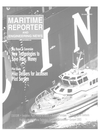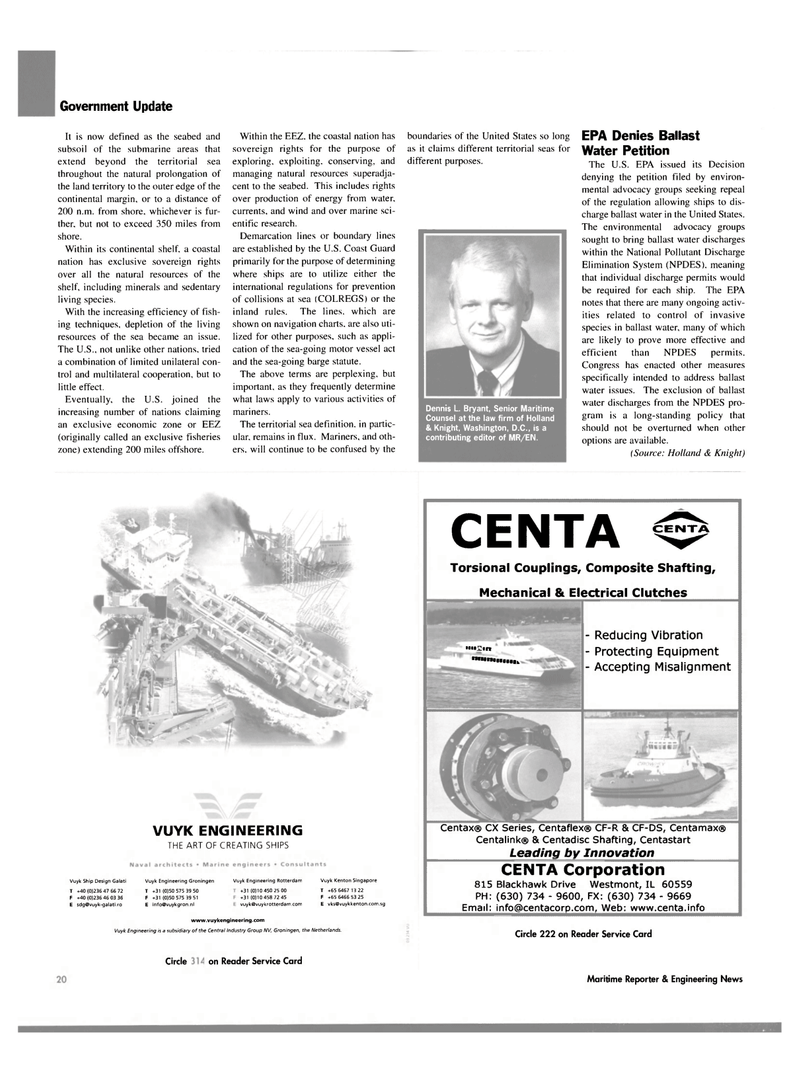
Page 22: of Maritime Reporter Magazine (October 2003)
Read this page in Pdf, Flash or Html5 edition of October 2003 Maritime Reporter Magazine
Government Update
It is now defined as the seabed and subsoil of the submarine areas that extend beyond the territorial sea throughout the natural prolongation of the land territory to the outer edge of the continental margin, or to a distance of 200 n.m. from shore, whichever is fur- ther. but not to exceed 350 miles from shore.
Within its continental shelf, a coastal nation has exclusive sovereign rights over all the natural resources of the shelf, including minerals and sedentary living species.
With the increasing efficiency of fish- ing techniques, depletion of the living resources of the sea became an issue.
The U.S., not unlike other nations, tried a combination of limited unilateral con- trol and multilateral cooperation, but to little effect.
Eventually, the U.S. joined the increasing number of nations claiming an exclusive economic zone or EEZ (originally called an exclusive fisheries zone) extending 200 miles offshore.
Within the EEZ. the coastal nation has sovereign rights for the purpose of exploring, exploiting, conserving, and managing natural resources superadja- cent to the seabed. This includes rights over production of energy from water, currents, and wind and over marine sci- entific research.
Demarcation lines or boundary lines are established by the U.S. Coast Guard primarily for the purpose of determining where ships are to utilize either the international regulations for prevention of collisions at sea (COLREGS) or the inland rules. The lines, which are shown on navigation charts, are also uti- lized for other purposes, such as appli- cation of the sea-going motor vessel act and the sea-going barge statute.
The above terms are perplexing, but important, as they frequently determine what laws apply to various activities of mariners.
The territorial sea definition, in partic- ular. remains in flux. Mariners, and oth- ers. will continue to be confused by the boundaries of the United States so long as it claims different territorial seas for different purposes.
Dennis L. Bryant, Senior Maritime
Counsel at the law firm of Holland & Knight, Washington, D.C., is a contributing editor of MR/EN.
EPA Denies Ballast
Water Petition
The U.S. EPA issued its Decision denying the petition filed by environ- mental advocacy groups seeking repeal of the regulation allowing ships to dis- charge ballast water in the United States.
The environmental advocacy groups sought to bring ballast water discharges within the National Pollutant Discharge
Elimination System (NPDES). meaning that individual discharge permits would be required for each ship. The EPA notes that there are many ongoing activ- ities related to control of invasive species in ballast water, many of which are likely to prove more effective and efficient than NPDES permits.
Congress has enacted other measures specifically intended to address ballast water issues. The exclusion of ballast water discharges from the NPDES pro- gram is a long-standing policy that should not be overturned when other options are available. (Source: Holland & Knight)
Vuyk Ship Design Galati
T +40(0)236 47 66 72
F +40 {0)236 46 03 36
E sdg@vuyk-galati ro
Vuyk Engineering Groningen
T +31 (0)50 575 39 50
F +31(0)50 575 39 51
E info#vuykgron.nl
Vuyk Engineering Rotterdam +31 (0)10 450 25 00 +31 (0)10 458 72 45 [email protected]
Vuyk Kenton Singapore
T +65 6467 13 22
F +65 6466 53 25
E vks^vuykkenton com.sg www.vuykengineering.com
Vuyk Engineering is a subsidiary of the Central Industry Group NV, Groningen, the Netherlands.
Circle 255 on Reader Service Card
THE ART OF CREATING SHIPS
VUYK ENGINEERING
CENTA ^
Torsional Couplings, Composite Shafting,
Mechanical & Electrical Clutches •WlHI "•""•iiiith - Reducing Vibration - Protecting Equipment - Accepting Misalignment
Centax® CX Series, Centaflex® CF-R & CF-DS, Centamax®
Centalink® & Centadisc Shafting, Centastart
Leading by Innovation
CENTA Corporation 815 Blackhawk Drive Westmont, IL 60559
PH: (630) 734 - 9600, FX: (630) 734 - 9669
Email: [email protected], Web: www.centa.info
Circle 222 on Reader Service Card 24 Maritime Reporter & Engineering News

 21
21

 23
23
